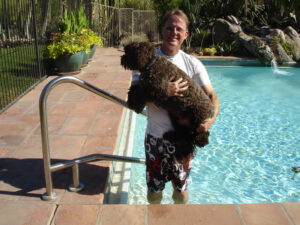
Let’s be honest. If you can’t train a dog very well, and that includes how you manage yourself, your dog’s training won’t get any better by getting angry. No one wants to be around someone with a temper problem. No dog wants to be around someone with an anger problem, either.
I learned long ago that you can’t do a good job of training a dog if you have a bad attitude. What I’ve always done is stop the lesson, and instead, go do something fun and relaxing with my dog. Go for a walk, play fetch, go swimming, or just hang out.
Then, take some time to figure out why you are getting angry. Is it really about the dog? Most times, I’d bet the answer is “no”. Bottom line, diagnose and fix why you are getting angry with your dog, and then fix your attitude.
What is my ideal picture of dog training?
A properly trained dog is not viewed as a fuzzy little human. Dogs have to learn like dogs learn. They are always trying to figure us out, while we should be trying to always figure them out. A well-trained dog is valued and loved by its owner for being a dog, and appreciated for all their amazing senses and abilities. They are patiently and diligently encouraged over time to display a willingness to obey, and to make connections between what you want and what they are supposed to do. They learn that training is enjoyable, especially with you. Every new desired behavior is introduced as if the dog is a total novice, and guided to learn everything there is to know about how to do that behavior enthusiastically and correctly. Foundational exercises are the first things taught. Then each new exercise is carefully added so that over time an entire structure of integrated trained exercises cause the dog to perform correctly. We don’t bully them into all of this, we work with them until they ideally get what we want 100% so they can do what we want 100%, recognizing this is just an ideal that we shoot for, not something they can ever attain.
So, is there a place for anger in dog training? I can think of a two examples where it might be. First, I can see getting angry if someone is being abusive to another person or dog in the training. Sometimes you have to confront that person and make them stop whatever they are doing, or at least get the dog away from that situation. I’ve had to confront some people over the years for their outrageous actions, and if you are around the dog world long enough, you might have to do the same. Second, I can see anger being a useful thing in training a protection dog to alert to a dangerous person. Protection dogs come to recognize that not all people are good, and that is a desired lesson for such a dog. Dogs that do real street work come to react to angry people, and that is just fine. The dog shouldn’t be unaware and unreactive in the face of danger. Properly trained protection dogs are taught to recognize and confront dangerous people in carefully planned steps, all the way until they actually are in a street fight with a criminal.
But, in day to day training, anger doesn’t fit into good dog training. Like any normal person training dogs over decades, you are going to have hard times going on the same time you are working with dogs. It is important to recognize what is going on with you and sort those things out. You should also be receptive to when others tell you that you are getting out of line. I’ve been contacted many times over the years asking for advice on what to do with someone in their family, or someone they are dating, who is being unkind to their dog. I always encourage them to set up some lessons so I can help them sort things out and talk to that person about a better way. Unfortunately, most times, they don’t follow up and I always wonder whatever happened to the dog. Sometimes the person won’t change, even after I’ve shown them the right way. I dealt with an angry alcoholic about a year ago, and even with his family there pleading with him to do the right thing, he kept getting more intoxicated and nasty. So, there aren’t always happy endings.
Let’s first start with showing you how to train your dog properly. Second, if things are not going so well in your life, there are community resources out there to help you out. Put those two things together, and you can take positive steps to solving your dog’s behavioral problems, and working yourself into a better situation. I’ll be honest with you if you are crossing the line, and I will expect you to shape up and do things correctly, or to responsibly find your dog a new and better home. I think that is a fair deal, don’t you?
